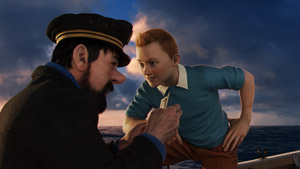Does Motion Capture Deserve Best Animated Feature Awards?
 Motion capture has come to the forefront of the discussion again with The Adventures of Tintin getting great reviews (but low returns), and three motion capture films contending for Oscar nominations. Motion capture, sometimes called performance capture, relies on the performances of real actors that are then applied to digital characters by the computer for motion and expression. It first hit the big screen with the 2004 Tom Hanks film, The Polar Express. Others have followed like Monster House, Happy Feet, A Christmas Carol, and Mars Needs Moms.
Motion capture has come to the forefront of the discussion again with The Adventures of Tintin getting great reviews (but low returns), and three motion capture films contending for Oscar nominations. Motion capture, sometimes called performance capture, relies on the performances of real actors that are then applied to digital characters by the computer for motion and expression. It first hit the big screen with the 2004 Tom Hanks film, The Polar Express. Others have followed like Monster House, Happy Feet, A Christmas Carol, and Mars Needs Moms.
These movies are always lumped into the Best Animated Feature category at the Oscars, but is it right? It doesn't really conform to the traditional definition of animation. It's really less computer animation than it is computer stylization. I do not mean to minimize the hard work of motion capture technicians. But the hard truth is, with the exception of some tweaking, performance capture replaces the animator with the actor. And the actors are feeling overlooked for their captured performances too. We need new Oscar categories.

Definition disputes aside, motion capture has yet to truly gain the affection of audiences. You'll hear people use words like "creepy" and "lifeless" to describe performance capture characters. Pixar has been proudly opposed to motion capture techniques, even going so far as to badge many of their films with an icon in the credits that reads: "100% Genuine ANIMATION! No motion capture or any other performance shortcuts were used in the production of this film."
Animating very cartoony motion with lots of squash and stretch on a realistic looking object may not look believable, as would realistic motion on a caricatured object. This is the pitfall of using motion capture devices to create final animation.
Lasseter is talking about the infamous Uncanny Valley, a proven phenomenon which turns people completely off to realistic characters because your brain knows that something isn't quite right. Animation has always been about exaggeration. We invented the camera to emulate reality.
There are mixed opinions on this. Post yours below.
